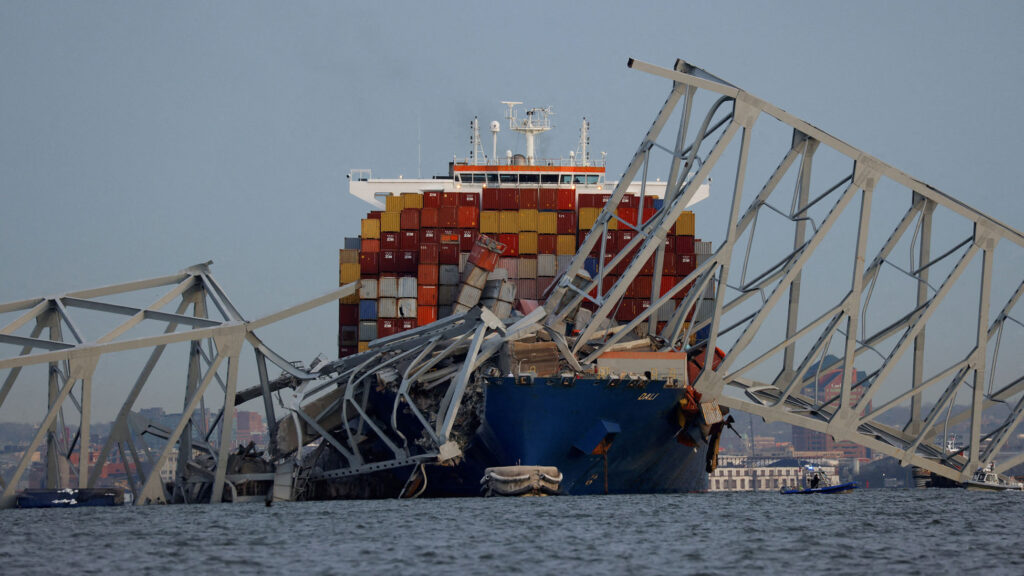Baltimore’s Francis Scott Key Bridge Collapse: The morning of March 26, 2024, brought a devastating blow to Baltimore City. The iconic Francis Scott Key Bridge, a vital artery connecting the city to its surrounding areas, crumbled after a collision with a cargo ship. This article delves into the details of the incident, its aftermath, and the ongoing investigation.

Table of Contents
Baltimore’s Francis Scott Key Bridge Collapse
At approximately 1:28 AM EDT, the MV Dali, a Singapore-flagged container ship, lost power and struck a support column of the Francis Scott Key Bridge. The impact caused the main spans and part of the northeastern approach of the bridge to collapse into the Patapsco River. The bridge, a steel arch continuous through truss bridge, carried a significant portion of traffic, including the Baltimore Beltway (I-695).
Immediate Impact and Rescue Efforts:
The collapse sent shockwaves through the city. Thankfully, a mayday call from the ship moments before the crash allowed authorities to limit vehicle traffic on the bridge, potentially minimizing casualties. A search and rescue operation was launched immediately, with efforts focusing on rescuing construction workers who were patching potholes on the bridge at the time of the incident.
Tragic Loss and Ongoing Search:
Two workers were heroically rescued, but a grim reality unfolded. Six other construction workers were missing and presumed dead. The search efforts continued for days, but the harsh conditions in the river ultimately led to a transition to recovery efforts. The families of the missing men are left grappling with immense grief and unanswered questions.
Investigation and Questions Raised:
The cause of the accident remains under investigation by the National Transportation Safety Board (NTSB). Key questions surround the cause of the power loss on the MV Dali, potential navigation issues, and bridge safety protocols during construction work. Transparency and accountability will be crucial in the coming months as investigators work to determine what went wrong.
Impact on the City and Beyond:
The bridge collapse has had a significant impact on Baltimore City and the surrounding region. Commuters face major traffic disruptions, with significant detours necessary. The Port of Baltimore, a crucial economic hub, has also been impacted as shipping traffic has been temporarily halted. Beyond the immediate logistical challenges, the city grapples with the emotional toll of this tragedy.
The Fallen Colossus: A History of Baltimore’s Francis Scott Key Bridge

The recent collapse of the Francis Scott Key Bridge in Baltimore marked a somber moment in the city’s history. This once-majestic structure wasn’t just a bridge; it was a testament to engineering innovation and a vital artery for commerce and community. Let’s delve into the rich history and significance of this fallen giant.
From Outer Harbor Crossing to Francis Scott Key Bridge
Construction began in 1972 on what was initially called the Outer Harbor Crossing. This ambitious project aimed to alleviate traffic congestion plaguing Baltimore’s growing economy. The bridge spanned the Patapsco River, connecting Dundalk in Baltimore County to Hawkins Point in Baltimore City. It carried the critical Baltimore Beltway (I-695), a major transportation route linking the city to the northeast and southwest regions.
Engineering Marvel and National Symbol
Upon its completion in 1977, the bridge was renamed the Francis Scott Key Bridge. The namesake, Francis Scott Key, was a lawyer and poet who penned the lyrics to the American national anthem, “The Star-Spangled Banner.” Legend has it that Key witnessed the bombardment of Fort McHenry during the War of 1812 from a location near where the bridge would eventually stand. The sight of the flag still flying over the fort inspired him to write the iconic words, “And the rockets’ red glare, the bombs bursting in air, Through the proof of the night Watch, were our proud flag still there.”
The bridge itself was a marvel of engineering. At the time of its construction, it boasted the third-longest continuous truss span in the world. The steel arch design offered not just strength but also an aesthetically pleasing silhouette that became a recognizable symbol of Baltimore’s skyline.
Economic Engine and Community Connector
The Francis Scott Key Bridge wasn’t just a scenic landmark; it was a vital economic engine. It facilitated the smooth flow of goods and people to and from the Port of Baltimore, a crucial hub for international trade. The bridge also served as a vital connection for residents on both sides of the Patapsco River, allowing for easier commutes and fostering a sense of community.
A Legacy of Progress and Loss
The collapse of the Francis Scott Key Bridge has left a gaping hole in Baltimore’s infrastructure and a deep sense of loss in the community. The bridge stood as a symbol of human ingenuity and progress, connecting people and driving economic growth. Its tragic demise serves as a stark reminder of the importance of maintaining aging infrastructure and prioritizing safety measures.
Looking Forward: Rebuilding and Remembering
The rebuilding of the Francis Scott Key Bridge is a monumental task, and the timeline for its completion remains uncertain. However, the resilience of Baltimore shines through. The city will undoubtedly rebuild the bridge, but it will never forget the lives lost and the families forever impacted by this tragedy.
This article serves as a snapshot of the Baltimore bridge collapse. As the investigation progresses, new information may come to light. We will continue to monitor the situation and provide updates as they become available.
Similar Posts:
Carolyn Bryant Donham, whose false accusation led to the lynching of Emmett Till, dies at 88


